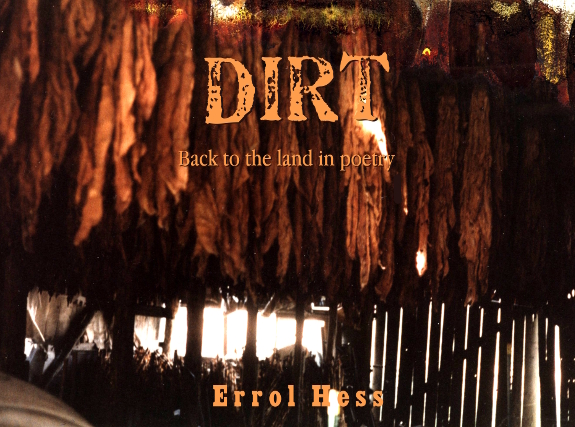
archives for 11/2016
Long before Mark and I moved
back to the land, my parents made the same journey. They stayed just
long enough to get me hooked on the idea then fled to the nearest town
a decade later.
Now's your chance to
hear about their journey straight from the horse's mouth. My father's
newest poetry collection spans those eleven years and includes gems
like Food Rules (showing how strangely obsessive I was at 5 years old),
along with many farming verses that are both beautiful and insightful.
Since I know the word
"poetry" probably made many of you hyperventilate in a corner as soon
as you read it, I thought I'd sweeten the pot this time around. Dirt
is free on Amazon
today and tomorrow. I hope you'll try a copy and then leave a review if
you like what you read. My father would really appreciate it!
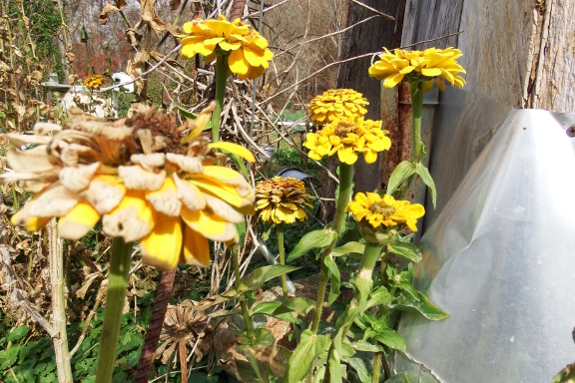
Last week's frosts
nipped back most of the tender summer plants, only missing a few
zinnias nestled up against the side of the house. In the garden, a few
late figs might manage to ripen despite the freeze and a few pepper
plants still have green leaves. Otherwise, though, the summer crops are
a thing of the past.
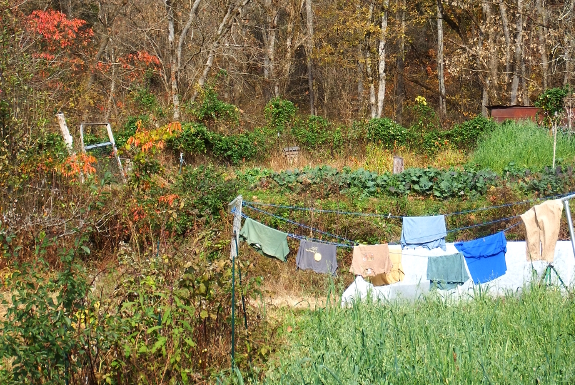
Leaf colors changed fast
with the wake of the weather change as well. All of the beautiful
yellows of mid October immediately started blowing out of the trees, to
be replaced by hints of red here and there.
This is such a golden
season --- warm enough to go outside in t-shirts in the afternoon but
cold enough to require warm blankets at night. There's something to
love about every season, but I think fall is my very favorite time of
the year.
Went out looking for a loveseat today and ended up with this 100 dollar bargain.
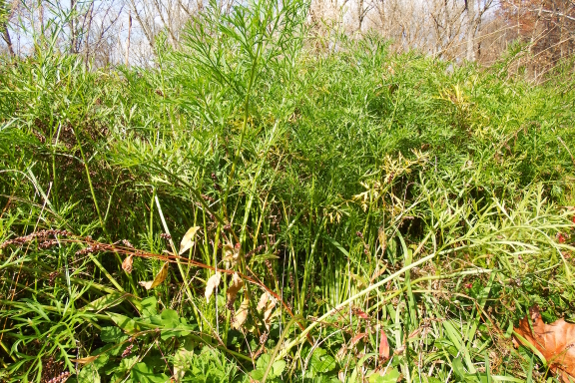
Harvest date for our
fall carrots varies widely. If I'm on the ball, I dig them in mid
September just in time to put down a fall planting of oats. This year, I've been doing the
bare minimum, so I let them ride until after the first frost sweetened
their orange roots.
I could have let the
crop go another month or so, actually, until hard freezes are
threatening. But I'm running out of the easy-to-harvest, gargantuan
carrots in the front garden (right outside the kitchen door), so I
figured I might as well dig up the mule garden's more moderately sized
haul.
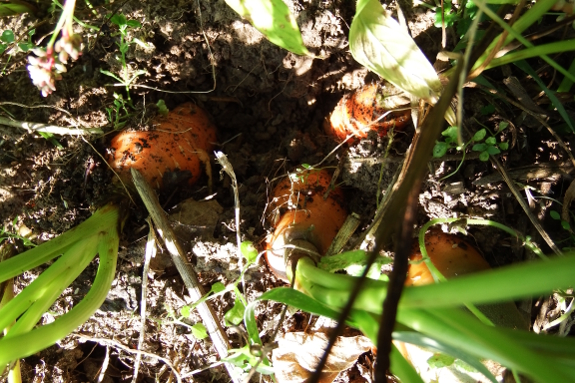
Even with the current
mini-drought (1.1 inches of rain in October), the carrots came out of
the ground relatively easily. Only one bed that hasn't received as much
organic matter was hard as a rock --- I felt like I was chiseling those
carrots out like fossils.
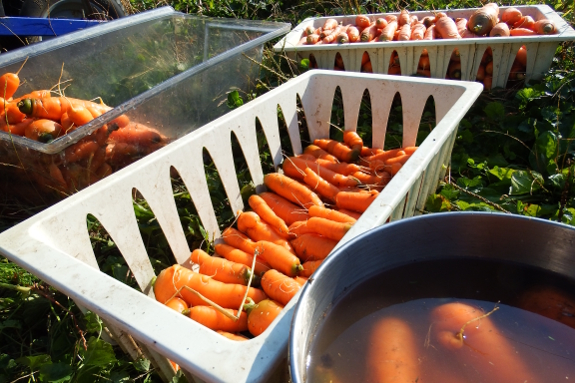
Half the harvest (not
all pictured) were easy to dig, wash, and sort in a couple of hours
work Wednesday afternoon. I figure our total yield for the fall carrots
will be around 2.5 bushels...and most of those are going in my stomach
since carrots are one of the few vegetables my body can currently
handle. Thank goodness I overplanted for the sake of the goats!
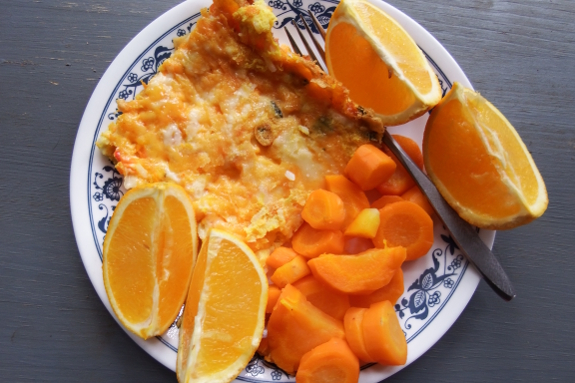
I'm now officially a FODMAP believer. After months of
awful diarrhea, nine days of a low FODMAP diet turned me 100% regular.
Time to start adding categories back in to see which one(s) were
messing me up.
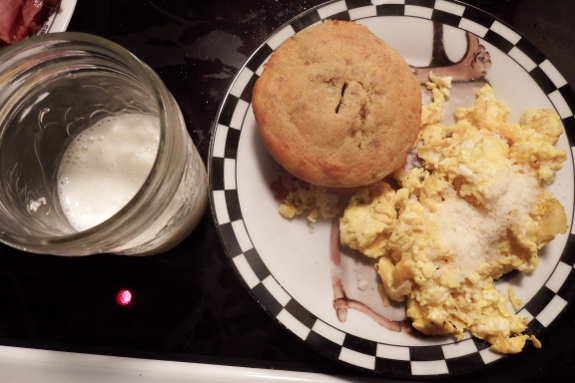
I started with milk,
which I was pretty sure wasn't going to cause a problem. After all, I'd
never had trouble with lactose intolerance in the past. Day 1 --- one
quarter cup of milk and all's well. Day 2 --- half a cup of milk and
back to the explosive diarrhea.
The interesting part is
that my symptoms occurred eight hours after imbibing. Which means all
of my previous correlation analyses (I ate x and then ran to the
bathroom immediately) are invalid.
Time to rest the gut
again, then move on to test two. Shall I hit honey (fructose) or garlic
(fructans) next?
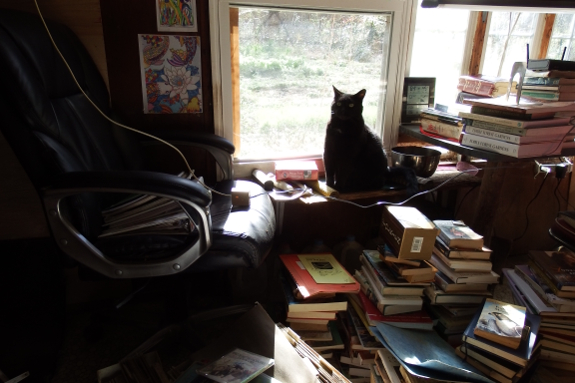
This year's top
reorganization priority is my homestead office. After finally caving
and buying a comfortable
chair this summer,
my current workspace was no longer working. Which was actually a
much-needed nudge, since I ended up with a lot of books to discard once I
pulled everything off the shelves.
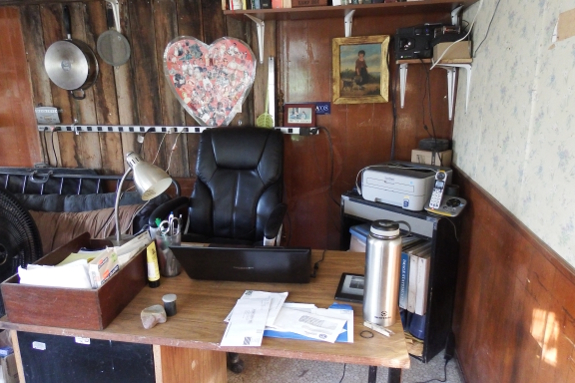
Here's phase two ---
shelves removed and only the items I use at least once a month returned
to the office zone. Mark has promised to build me a storage futon to
continue the renovation into the left side of the photo above, and I'm
pondering that big bare wall on the right with its ancient floral
wallpaper. Am I really to the point in my homesteading adventure where
I'm considering adding a coat of paint?
I think I like the Tractor Supply buckets a little over the Lowes equal size bucket.
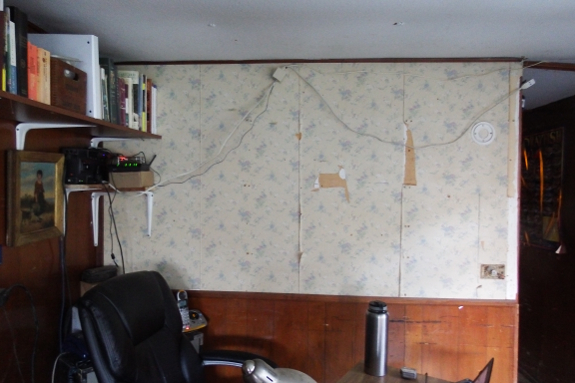
I don't usually notice
interior design, but off and on over the last decade I've been drawn to
certain spaces. What have they all had in common? Accent walls --- one
wall of bright, stark color that contrasts vividly with the rest of the
space. I figured the now
shelfless wall could
be my first stab in that direction.
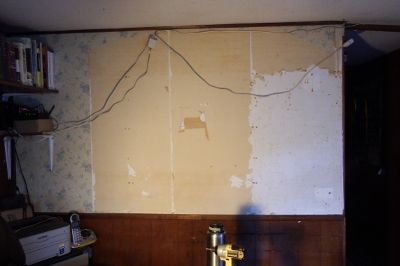 But before I could start
thinking about colors, I had to strip off the old wallpaper. My
previous experience with wallpaper removal involved a steamer, some
kind of chemical, and a seemingly endless amount of scraping. I wasn't
particularly anxious to repeat the process.
But before I could start
thinking about colors, I had to strip off the old wallpaper. My
previous experience with wallpaper removal involved a steamer, some
kind of chemical, and a seemingly endless amount of scraping. I wasn't
particularly anxious to repeat the process.
To my surprise, when I
tested a bit of my office wall Saturday morning, I found the paper easy
to remove with only the supplies I had on hand. Rip back the plasticy
outer layer, dampen the plain paper below with a wet rag, then scrape.
Very satisfying! Looks like step one of the accent wall is well within
my reach.
What would I do different on
the milking stand we
built two years ago?
Make the neck brace out of
two pieces of curved solid plywood.
The way I built the neck
brace in pieces made for weak points an aggressive goat could
eventually break apart after days of banging during milking time.
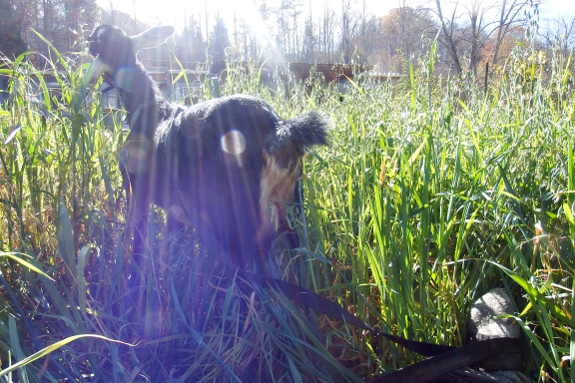
Sometimes when I'm lazy,
I bring the goats to the garden without a tiedown stake. Instead, I
slip their leashes over my foot and settle in to read.
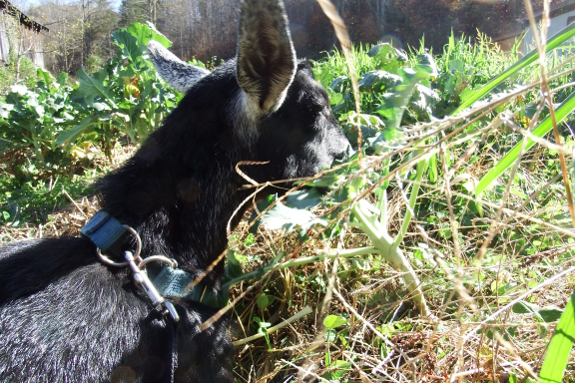
The trouble with the toe
tiedown is that I get engrossed in my book and the goats yank, yank,
yank until they get into something they're not supposed to. Bad,
Artemesia! That broccoli is for humans!
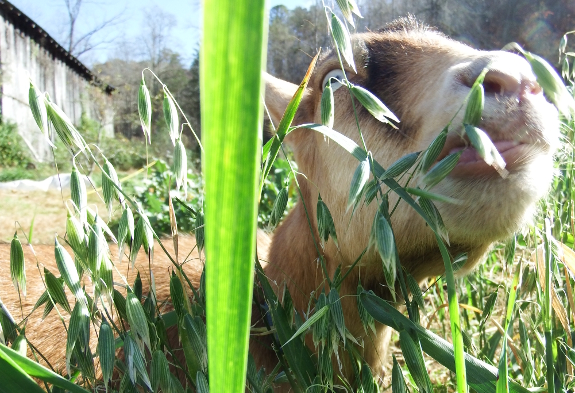
You know you've been had
when your goats stick out their tongues at you.
We harvested a good size
basket of carrots today.
Yes...we still use the refrigerator
root cellar to store most of the carrots.
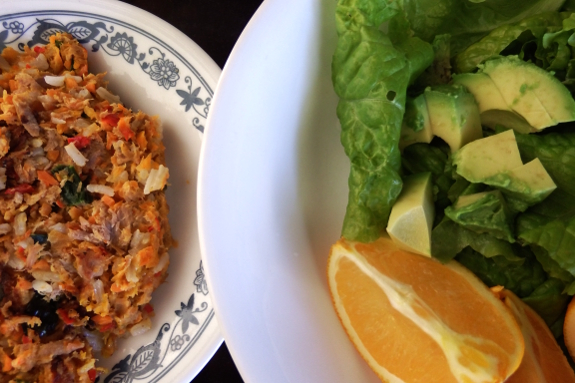
I hope that most of you
have perfect digestion. But I thought I'd share my FODMAP
reintroduction plan anyway since it's estimated that 10 to 15% of the
world population suffers from irritable bowel syndrom and since a
low-FODMAP diet has been proven to mitigate symptoms in 70% of cases,
especially if your problems run toward, well, the runs. In other words,
I expect hundreds of our readers could benefit from this information.
If that sounds like you
and you turned regular after two to eight weeks on a low FODMAP diet,
it's time to start testing which category or categories of FODMAP are
bothering you. The idea is to pick foods that have only one type of
FODMAP in them, then to test each food at a low, medium, and high level
over the course of three days. If you experience symptoms, you note
that category down as a no-go (for now), then rest your gut for at
least three days until it's back in shape before testing the next round
of food.
Here's the information
that's harder to find --- which foods are appropriate test subjects.
After extensive internet searching, I came up with:
| Test food |
Category |
Amounts (day
1, 2, and 3) |
| Honey |
Fructose |
1 teaspoon, 1 tablespoon, 2
tablespoons |
| Avocado |
Polyols (sorbitol) |
1/4 avocado, 1/2 avocado, 1
avocado |
| Sweet potato |
Polyols (mannitol) |
3 ounces, 5 ounces, 7 ounces |
| Almonds |
Galactans |
12 almonds, 16 almonds, 20 almonds |
| Garlic |
Fructans (vegetables) |
1/4 clove, 1/2 clove, 1 clove |
| Bread or pasta (made with wheat) |
Fructans (grains) |
1 slice of bread, 2 slices of
bread, 3 slices of bread; or 1/2 cup pasta, 3/4 cup pasta, 1 cup pasta |
| Milk |
Lactose |
1/4 cup, 1/2 cup, 1 cup |
One study following up with folks who had been on the low FODMAP diet a year earlier suggested that wheat, onions, and dairy are the most likely to still be giving people trouble at that late date. So (despite what I did, starting with milk as my first trial food), I recommend testing in the order shown above so you can let your gut heal for an extra month before attempting the real heavy hitters. Good luck!
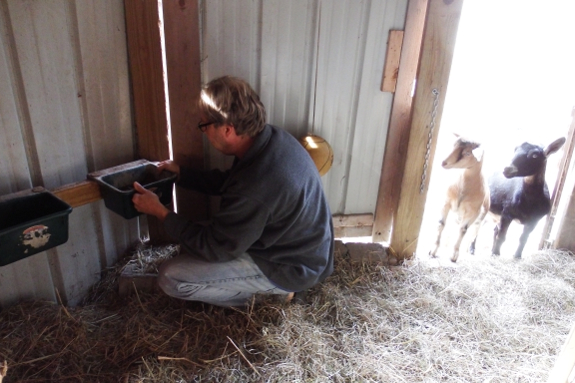
Our current herd isn't
nearly as destructive as when the ornery and horned Abigail was a
member of the crew. But Aurora is a major climber and never grew out of
her
childhood obsession with dancing in the mineral feeders. Time for Mark to move one
of the two to a new spot in hopes we can keep our doeling's feet on the
ground where they belong.
Brussels sprouts are so loaded with yummy goodness they're leaning over.
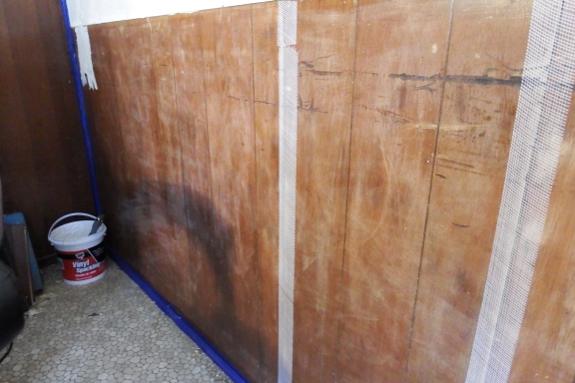
The handy thing about
waiting to do any interior design until I'd written a book covering the topic is
that I can learn from other trailersteaders' trial and error. Turns out
wood paneling is best sanded pre-painting, so I scuffed up the finish
thoroughly in preparation for dealing with the bottom half of the wall.
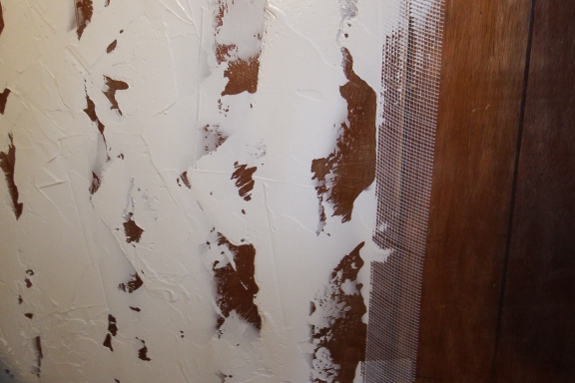
I'd also gotten it into
my head that I wanted to create a pseudo-stucco texture. So rather than
simply filling in the indented lines of the paneling (so it didn't look
so much like painted panels), I went a little nutty with the joint
compound. As you can see in the image above, I also used mesh tape
along the true seams so the thicker-than-usual spackling doesn't crack.
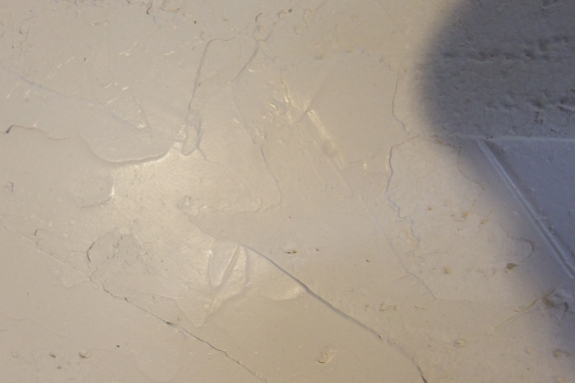
Here's part of the
texturing on the upper half of the wall. Time to let it dry, then
primer and paint. Fingers crossed my experiment looks good rather than
turning into an eyesore.
The Willow trees we are growing for the building with living trees experiment are well over 6 feet and might be ready for sculpting soon.
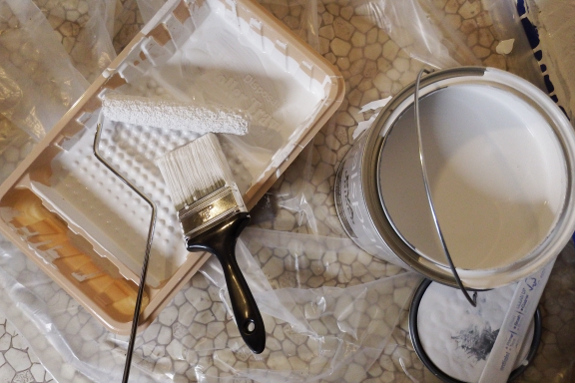
I'm getting a rather
absurd amount of joy out of painting my
office wall. I
suspect that if the area was even twice a large, it would be a chore
rather than a delight. But as is, it only takes about 15 minutes to put
on a coat of primer or paint, so I'm always itching for another round.
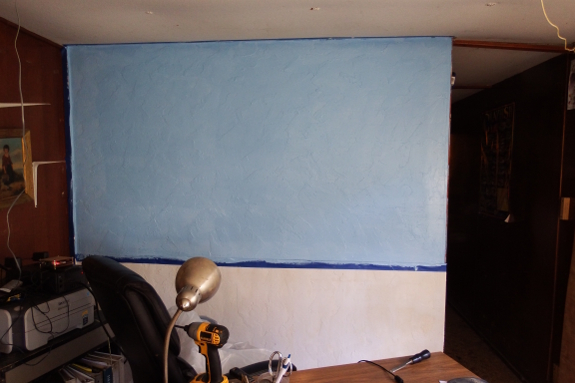
Here's the top half of
the wall after the first coat went on. The bottom will be an earthy
yellow/orange/brown, simulating a landscape in two blocks of color.
Stay tuned for more photos once the paint dries!
Broccoli continues to produce for us and is still one of my favorite garden items.
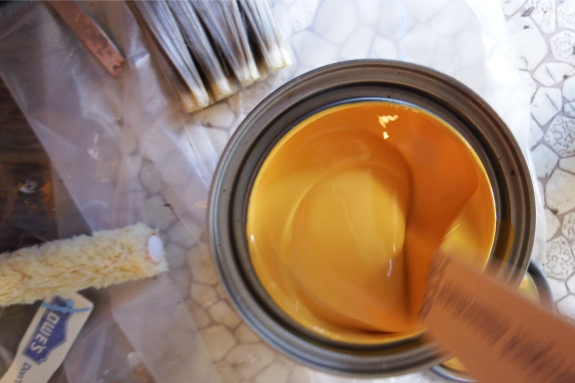
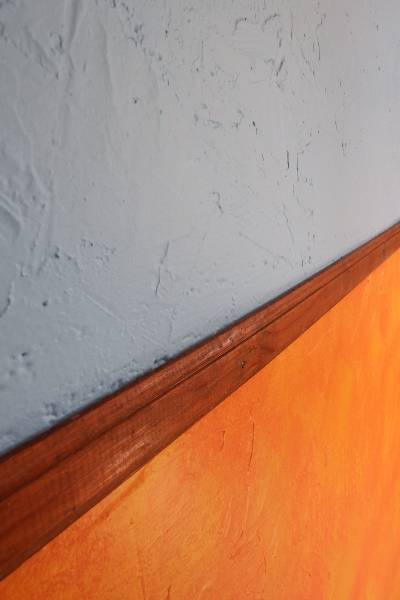 So how did my pseudo-stucco
turn out? I have to admit that it doesn't look all that much like
stucco. If I was going to repeat the project, I might follow
Roland's advice and add some sand for fine-grain texture. Alternatively, I might just
try to use stucco itself since even non-glossy paint has a plasticy
sheen once dried on the wall.
So how did my pseudo-stucco
turn out? I have to admit that it doesn't look all that much like
stucco. If I was going to repeat the project, I might follow
Roland's advice and add some sand for fine-grain texture. Alternatively, I might just
try to use stucco itself since even non-glossy paint has a plasticy
sheen once dried on the wall.
Those caveats aside, I
think my accent wall turned out really well...even if it doesn't look
much like stucco. I really like the texture (wouldn't change a thing
there!) and my two-tone bottom half of the wall looks really good up
close.
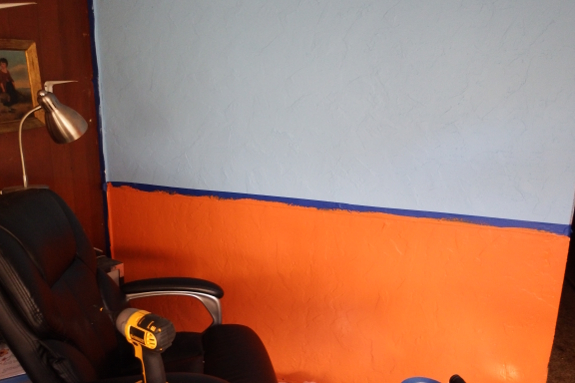
I wasn't so sure after I
put down the first coat, though. I
selected the paint colors online then sent Mark to pick them
up, and I wasn't quite expecting my orange-brown to be quite so, well, orange.
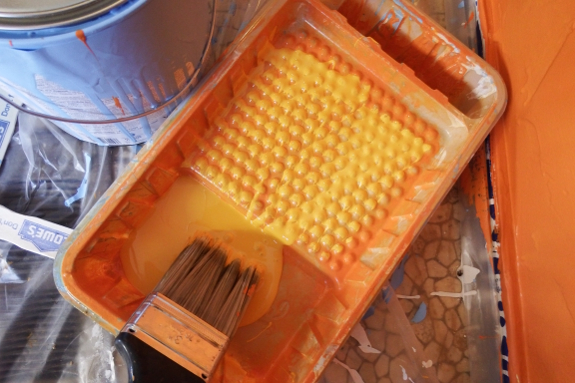
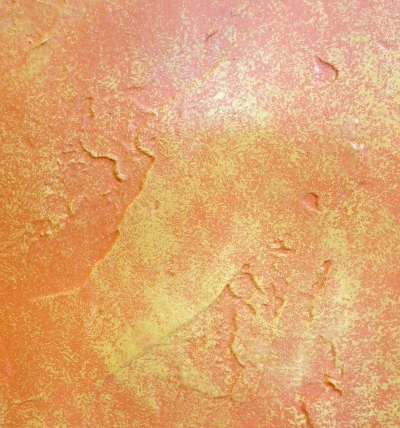 Luckily, I'd never planned to
paint the whole wall in one color. After putting down two coats of the
rather neony hue, I pulled out the yellow ochre I'd also selected.
Brushing a very small amount of paint onto the top of a roller tray, I
barely wet a roller in the paint. Then I lightly rolled over the
textured wall, pressing down more firmly in raised areas that I wanted
to accent.
Luckily, I'd never planned to
paint the whole wall in one color. After putting down two coats of the
rather neony hue, I pulled out the yellow ochre I'd also selected.
Brushing a very small amount of paint onto the top of a roller tray, I
barely wet a roller in the paint. Then I lightly rolled over the
textured wall, pressing down more firmly in raised areas that I wanted
to accent.
The result was a very
rocklike texture that definitely made the wall work. Tack the trim back
in place and I could almost forget my office is located inside a
trailer. Now, which wall should I tackle next?
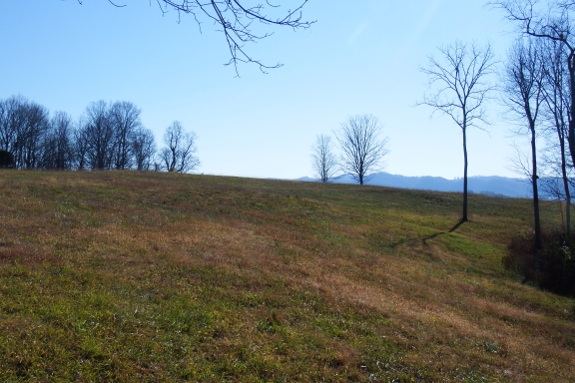
I dropped by Sugar
Hill on a frosty Saturday morning for a quick hike.
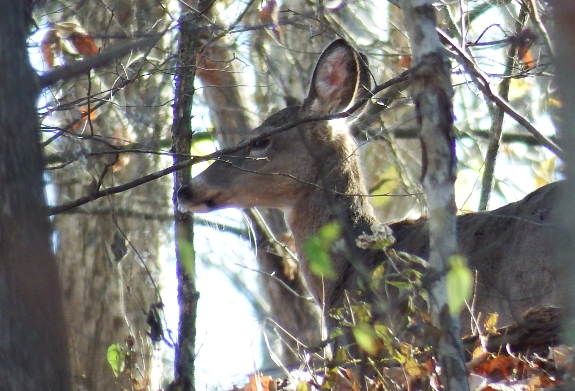
After spooking a pair of
does, I caught back up to them further along the trail. I didn't take a
photo, but I passed a flock of turkeys too --- unsurprising since I've
seen more of the latter this year than ever before.
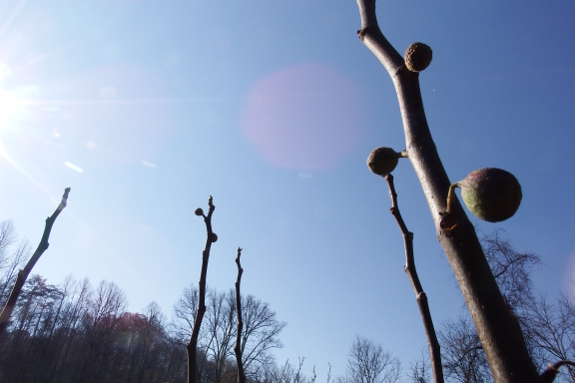
The last leaves fell today and Anna picked the unripe fruits to give to the goats.
Tomorrow, we'll wrap.
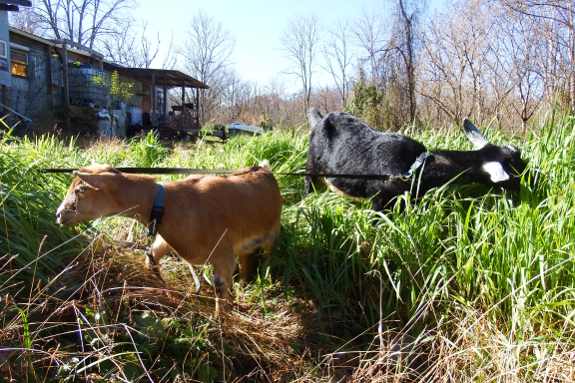
Poor Artie developed a
bald spot on one side of her neck a few weeks ago. I assumed she'd just
scraped it on something, but the patch got bigger over time and then
one popped up on the other side too.
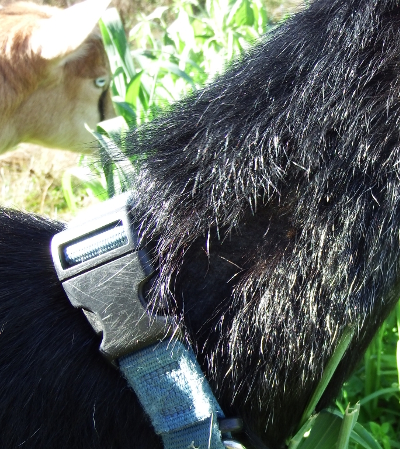 I'm not 100% certain what's
going on, but the internet suggests this may be a normal reaction by
some does to the hormone changes associated with drying off. Artemesia has been slowly backing off on
letting her daughter nurse for a while and now she's pretty close to
dry.
I'm not 100% certain what's
going on, but the internet suggests this may be a normal reaction by
some does to the hormone changes associated with drying off. Artemesia has been slowly backing off on
letting her daughter nurse for a while and now she's pretty close to
dry.
It's also possible the
issue could be a mineral deficiency or a parasite infection, though. I
figure the latter's pretty unlikely since Artemesia hasn't been
scratching the bare spots and I've seen no sign of critters. To rule out the former cause, I'm getting some fresh minerals to go
with her kelp just in case our doe is unwilling to eat out of Aurora's
former sandbox.
Have any of you had a
problem with balding does? What, if anything, did you do to fix the
problem?
We've got four Hazel Nut
bushes.
Just as they're dropping the
last leaves Anna decided it was okay for Artemesia to nibble on a few.
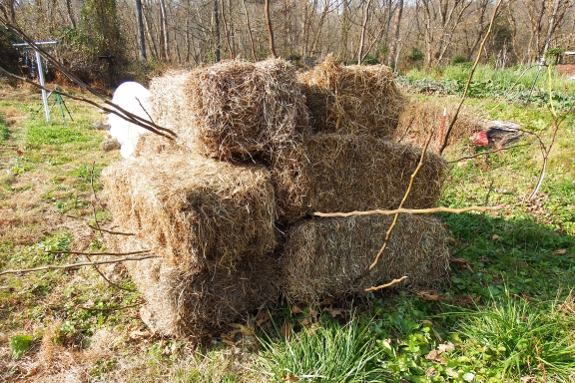
I'm trying a different
method of winter-protecting our largest fig tree this year. I call it
the hay porcupine.
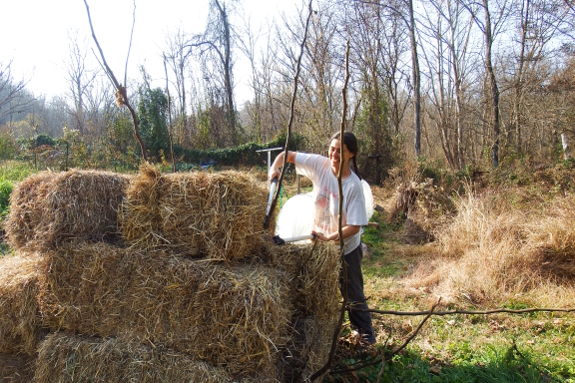
I would have considered
this technique far too wasteful if we hadn't dramatically overbought on
hay in fall 2015. But I'd already decided to mulch with the eleven
leftover bales that our goats would prefer not to eat. Why not use them
first to insulate our fig's many branches?
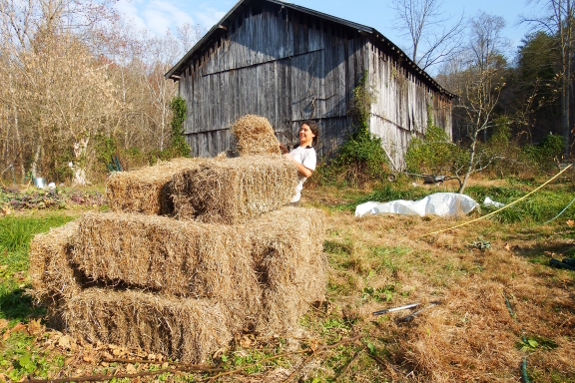
After snipping back
limbs that spread past the protection of the hay, I put one final bale
on top.
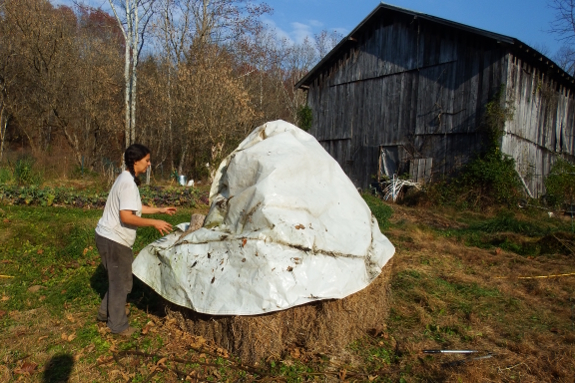
Then I topped it all off
with a tarp. Only time will tell whether the hay porcupine trumps the leaf
cylinder as our fig protection method of choice.
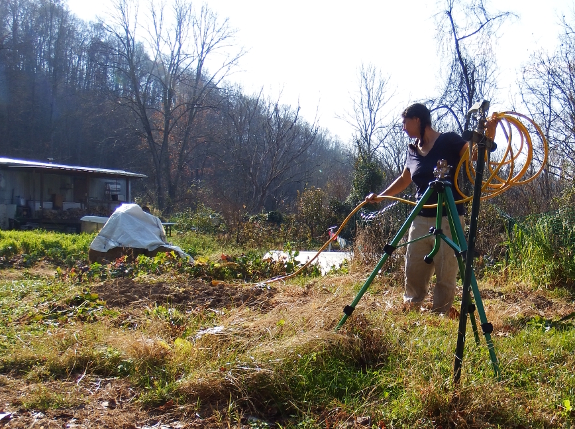
I left the hoses out
longer than usual this year because I was debating watering a few more
times. After all, the ground is bone dry.
Still, the few things
still growing in the garden --- leafy greens, lettuce, broccoli,
brussels sprouts --- seem to be doing okay despite the drought. And
with nights hitting the low 20s, I was afraid the hoses were going to
freeze and split. So I gathered them up and put them away. From now
until spring, the garden will have to depend on rain.
There was more dancing
compared to last year.
We decided to go with Monte
Cristo again....he's a sure thing.
How much does a high quality
goat date cost these days?
We paid 75 dollars and felt
like we got our money's worth.
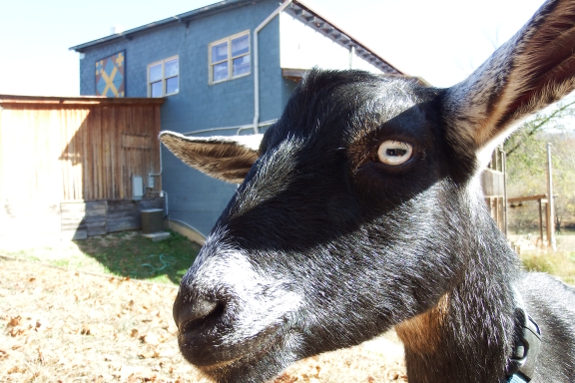
Artemesia keeps going
into heat when Monte's
mom is out of town. This time, I called at the first sign of yelling.
"There's only a little bit of clear mucous, no flagging yet," I said.
"I'm going out of town
first thing tomorrow morning," Monte's mom replied.
"Today it is, then."
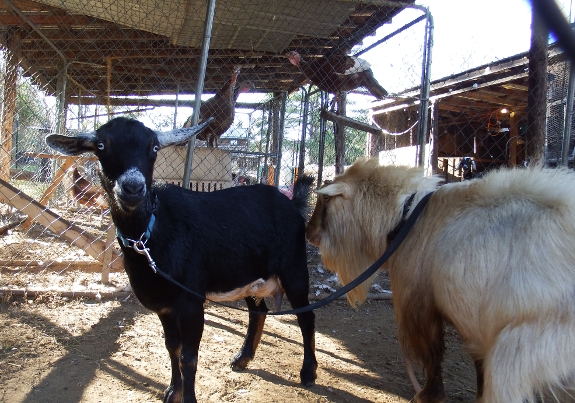
Luckily, by the time we
got to the location of our picnic lunch, Artemesia was starting to
flag. And when we brought her to Monte, she was definitely in standing
heat. It took him a few tries, though, to get in position when her tail
was up and out of the way. But we're hopeful Artie now has another set
of buns in the oven.
Not that we can do
anything about it, but we're hoping for two boys this time around.
Artie has such prime genetics that it would feel wasteful to eat girl
kids, so boys would take that difficult decision out of our hands.
Either way, you should mark your calendars for April 10 for the first
round of cute goat pics!
National Black Cat day is
today.
I guess Huckleberry will be
expecting an extra cat treat this evening.
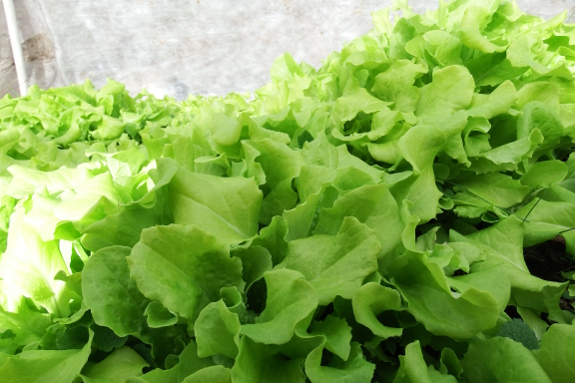
The uncovered lettuce in
the main garden is finally biting the dust. Luckily, the quick
hoop we erected near the end of October has sheltered our younger
bed. These crisp green leaves are ready to eat now and if the weather
remains mild might feed us for two more months.
The Oregon
battery powered chainsaw
continues to impress us.
We had to take out this
Walnut stump to make the new quick hoop fit.
 Those of you on my email list
will already be aware of the secret I've been hugging to my chest for
the last 2.5 years --- my second life writing about werewolves.
Those of you on my email list
will already be aware of the secret I've been hugging to my chest for
the last 2.5 years --- my second life writing about werewolves.
To be honest, fiction
has always been my greatest passion. Non-fiction serves a purpose --- I
love to learn what has succeeded or failed for others and to pass
on the favor by sharing my own experiences. But fiction is the treat I
look forward to at the end of a long, hard day. In fact, I read about
thirty novels for every non-fiction book I open, with genres running
the gamut from fantasy to women's fiction --- basically, I read
everything except horror and poetry.
When I was in high
school, I was astonished to find Isaac Asimov in the non-fiction
section with a whole shelf of books to his name. I'd enjoyed his
fiction (particularly the Norby series he wrote with his wife) and
was astonished to see that he had a line of non-fiction as well.
 But when the time came to
publish my own speculative fiction, I was too chicken to put it under
my own name. So I invented Aimee Easterling, who has since gone on to
become a USA Today bestselling author. (Yes, I do think about my
fiction persona in the third person. In case you're curious, her
last name is my husband's maternal grandfather's last name --- my way
of (kinda) taking Mark's surname in the end.)
But when the time came to
publish my own speculative fiction, I was too chicken to put it under
my own name. So I invented Aimee Easterling, who has since gone on to
become a USA Today bestselling author. (Yes, I do think about my
fiction persona in the third person. In case you're curious, her
last name is my husband's maternal grandfather's last name --- my way
of (kinda) taking Mark's surname in the end.)
So if you've ever
wondered why I haven't written quite as much non-fiction in the last
couple of years --- that's why. Aimee's been busy taking over my
fingers and typing out her tall tales instead.

I know most of you don't
read urban fantasy, so I won't bore you with details about her books in
the future. But if you're interested, I'm running a big sale on my 2016
series at the moment with the prequel
free and the other books marked
down to 99 cents apiece. Meanwhile, Shiftless is always
free on all retailers as a sampler of my earlier fiction work.
And even if you are sublimely uninterested in fantasy, I thought you might like to
see yet another way that homesteading has helped us fulfill our dreams.
By keeping our expenses low and growing much of what we eat, Mark and I
are able to pursue our passions to the hilt. Who knows what will come
next?
Our longest quick hoop ever stretches almost the entire distance of the garden.
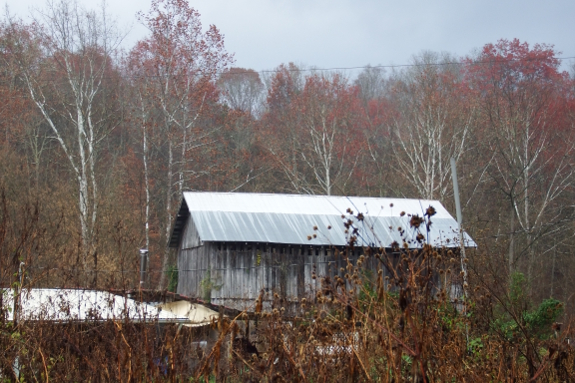
We feel lucky to have
been unaffected by the wildfires currently burning in North Carolina,
Tennessee, Kentucky, and elsewhere. Even the smoke has mostly passed us
by --- the photo above captured a rainy Saturday morning rather than
the smoky haze it initially appeared to be.
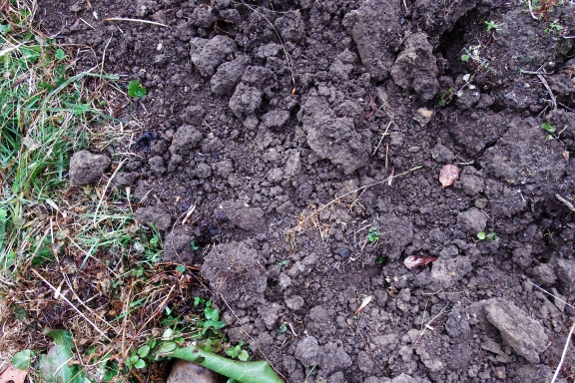
I doubt that extended
sprinkle did much good in the fire-prone regions since it hasn't even
managed to wet our parched soil..and we're officially only in a
moderate drought. This bed where I dug carrots a couple of weeks ago
still looks very much like it did the day I pulled the crop out of the
ground.
Of course, I have to
admit that our farm tends toward soggy and I'm actually a little glad
for the ease that dryness brings. But I'll be hoping for rain to quench
the flames elsewhere and to water gardens for those of you whose soil
is now bone dry. Here's hoping the drought is a mere memory by the time
spring gardens hit the ground in 2017.
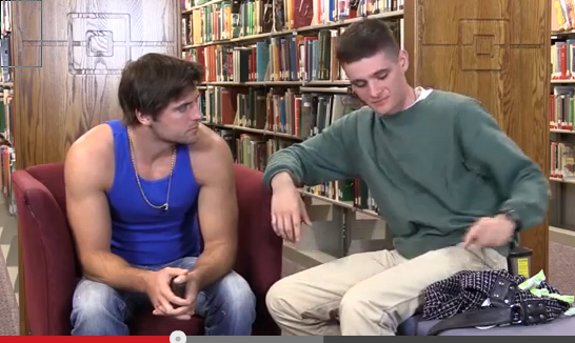
My classmate from film class
posted one of our projects on his Youtube channel.
One thing we learned was that
his video camera was not as compatible with my boom microphone which
results in the audio being a little tinny.
The assignment was to
recreate a scene from a famous movie and our group settled on the
John Hughes classic The Breakfast Club.
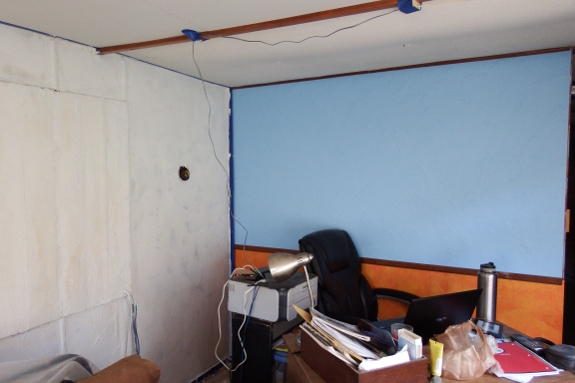
I was going to wait to
take after photos until the room was more in order, but didn't want to
leave you hanging too long! So here's the completed accent wall, with
lots of clutter in front of it since I had to move furniture to access
wall two.
The wall on the left
side of the photo is this week's project. It's on the north side of the
trailer and is very irregular --- we boarded up absent windows, and the
wall beneath what was once a hole was pretty water-damaged when we got
the trailer. Rather than replacing large swaths of wall, I'm hoping
some roughing up with more texturing will do the trick. Stay tuned for
more photos as the project progresses.
Maybe a lush patch of oats becomes crispy to goats in the cold weather?
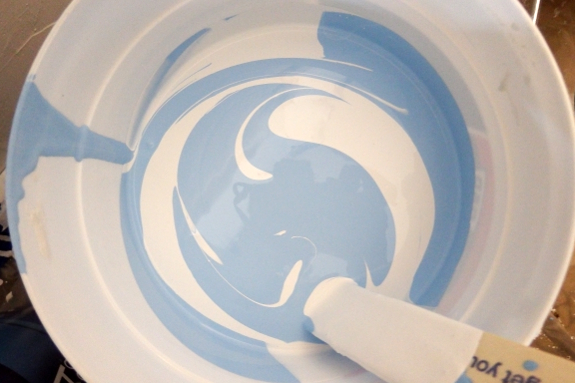
The internet suggested
making the rest
of the walls in a room the same hue but three shades lighter than
the color of the accent wall. I suspect they meant for me to look at a
paint chip and go down three rows from my present color to find my new
color, but I instead got out a clean bucket and mixed a bit of blue
with a lot of white. (Yes, I marked the side of the bucket so I
can recreate the color if I end up wanting more.)
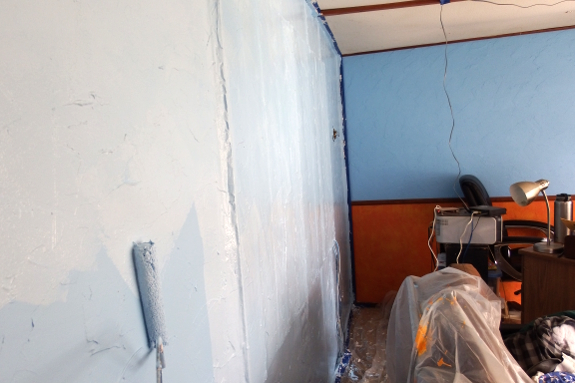
I remembered from the
accent wall that the paint gets a lot darker as it dries, so I went
lighter than I thought I'd want the wall to be. I'll have to take an
after photo later once everything's dry so you can see what I mean ---
this photo shows the paler paint as it's being rolled on.
It's amazing what a
difference changing over from dark wood paneling to pale blue makes in
the room. I suspect that once I get over having my office space
disrupted, this will be another of those projects that I kick myself
for not embarking on years ago.
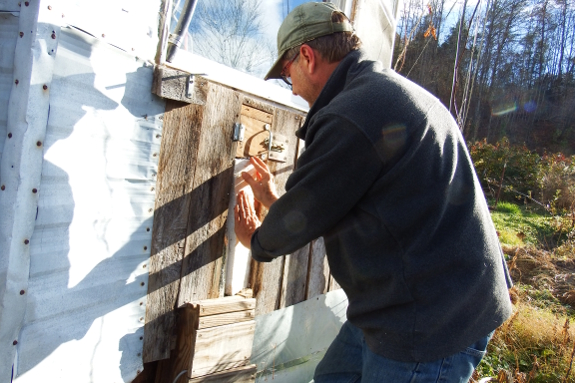
We've had such a mild
autumn that we're still burning last year's firewood. In fact, we
haven't even split any firewood yet --- we're still working through the
stockpiled bounty we stacked on the back porch while cleaning out the
shed last spring.
But the weather abruptly
shifted at the beginning of this week. A low of 16 means frozen ground,
a skim of ice on pools in the creek...and waking up to a waterline
frozen where it enters the house.
In large part, I think
the problem is that I didn't ever get around to unhooking the outside
hose and closing that access
hatch. But Mark went ahead and added more insulation to our inlet
anyway. Luckily, our freezes don't tend to burst the line, they just
mean we have to wait until the sun hits before we enjoy running water
once again. A small price to pay for our isolation out here far from
any city water system.
It's a struggle to get a cute
image of Aurora these days.
Maybe she's going through her
sullen teenager phase.
She's been more vocal since
her Mom came back last week smelling like a buck.

One summer, I decided I
wanted to learn to identify clouds. My new enthusiasm hit a major
roadblock, though --- in our neck of the woods, pillow-like cumulus
clouds are by far the most common and I couldn't seem to spot anything
else.
Fast forward ahead to
this year. I'm not sure whether our current drought has impacted clouds
or whether I've just been spending more time peering at the sky. Either
way, I've been catching several different types, like the altocumulus
clouds above...

...and the streaky
cirrus clouds shown here. (Or at least that's what I'm guessing they
are based on five minutes of internet research.)
The tufty cloudlets in
this post are higher and presumably drier than the cumulus clouds I'm
more used to. So maybe they are associated with the drought after all?
Turns out Thanksgiving was the perfect day to find a good spot for Anna's new sign.
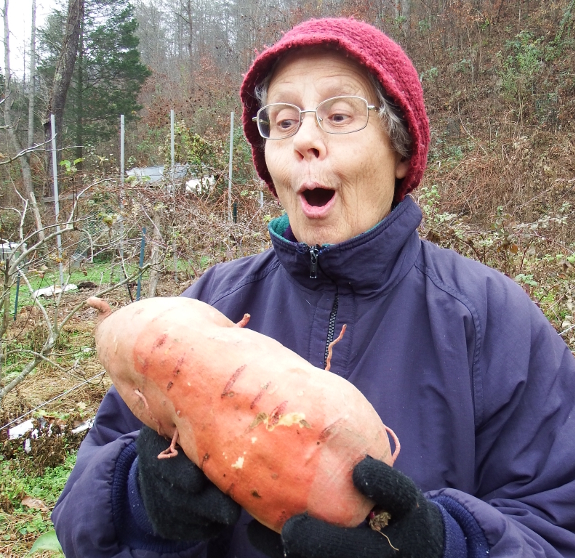
Mom and I are very
easily amused. I pulled out one of our biggest sweet potatoes of the
year for Thanksgiving dinner and she immediately exclaimed: "It looks
like a baby pig!"
"How much do you think
it weighs?" I asked.
Mark guessed 2.25
pounds, Mom guessed 2.5 pounds, and I guessed 3 pounds.
We were all wrong. The
baby pig weighed in at 3 pounds and 4 ounces, enough to serve as a side
for eight people instead of just three.
We did some Black Friday
shopping today in the form of an 80 straw bale delivery.
Big thanks to Walter and
Dawson for their time and a nice Punkin
update.
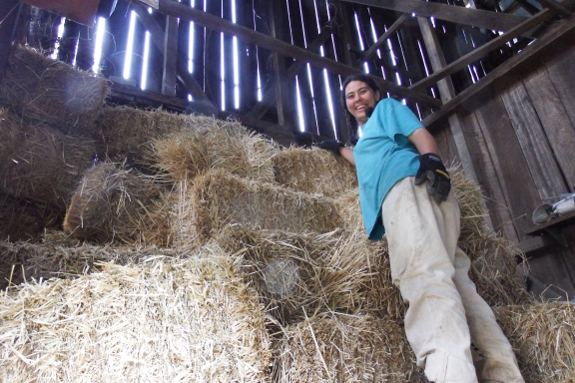
Building a mountain of
straw in the barn was a delight with the hauling assistance of the
Kubota. Using the pyramid approach, I was able to stack most of the
bales (with Mark carrying them in from the outside).
I eventually had to relinquish control of the project to the tall guy
with upper body strength, though. There's a limit to how many bales I
can throw over my head and Mark's extra eight inches made a big
difference putting away those last dozen bales.
Walter gave us a Jarrahdale
pumpkin as a bonus with the straw.
It has a slate green color
with a hard skin and originates in Australia.
We should make a point to
save some seeds and see how they grow here.
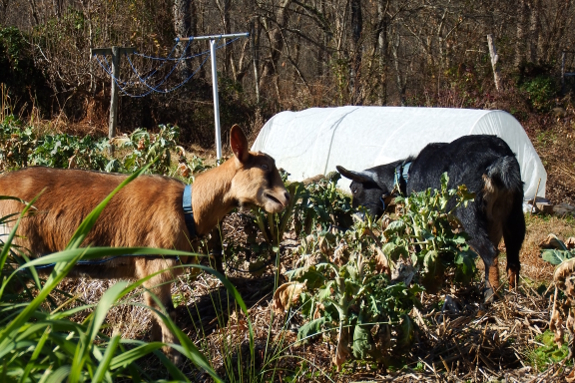
There's a fine line
between letting the goats eat human-friendly produce and letting winter
kill off the crops so badly even Artemesia turns up her dainty little
nose.
That sweet spot for broccoli appears to be after a couple of nights in
the teens. The plants are droopy and no longer prime for our own
consumption, but the girls still think they taste ten times better than
oats and honeysuckle.
I think I get the same
amount of enjoyment out of watching our does dine as I get by eating
vegetables myself.
What was the straw bale load
limit of the Kubota X900?
Making the load three layers
high maxed us out at 15 straw bales.
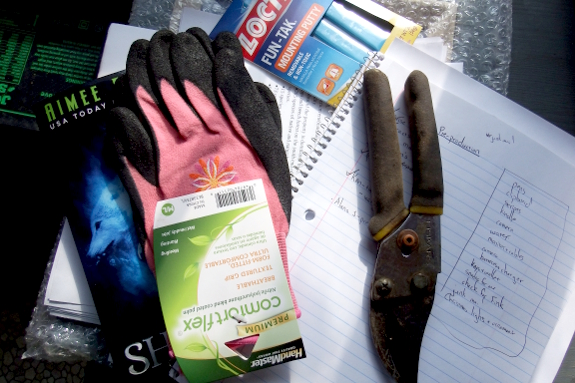
What do these items have
in common?
They're all going to be
used in Mark's final film
project of the semester, tentatively titled Lemons for Christmas.
It's a big, exciting
collaboration for the two of us. I wrote the script, Mark hired actors
and a director of photography, then I pulled together props and
pre-production checklists.
Now for filming, where
Mark will be the big guy on set! Stay tuned for more pictures, then,
eventually for a video as the project comes together.
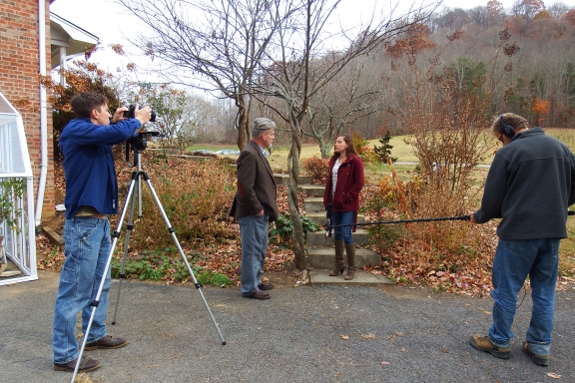
Monday, Mark and I
filmed Lemons for
Christmas with the
help of four very amazing people. It was an experience unlike any I'd
ever had before and I felt so lucky to have been able to take part.
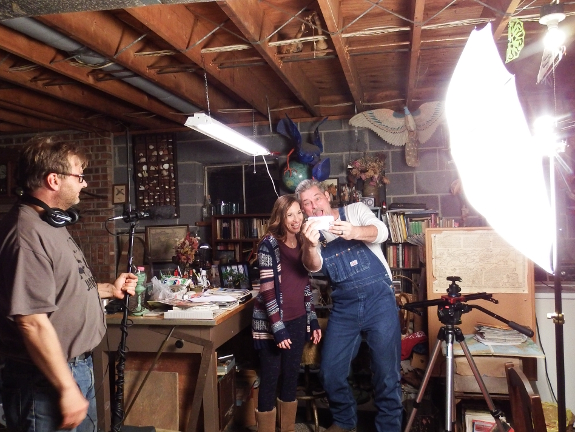
Our two actors were
professional, believable, and just plain fun. I wasn't expecting such
nice, down-to-earth people who could also reliably turn into characters
on command. The upshot? I highly recommend Myranda and Jim for all of your filmmaking
needs.
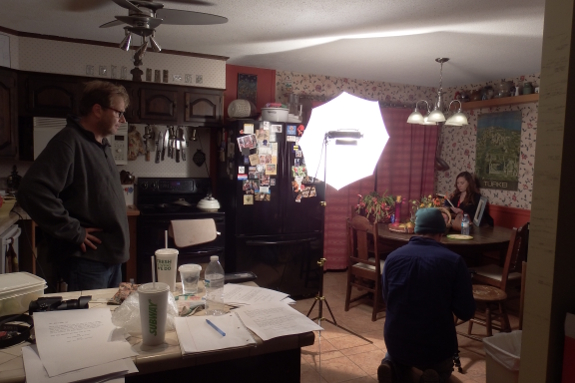
Mike
Fink was equally
astonishing as a director of photography. Mark hasn't taken a
cinematography course yet...but I think he got about a month's worth of
education in those six short hours.
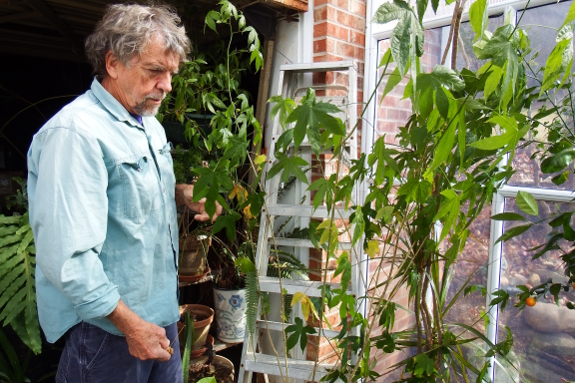
And don't forget Ken,
who lent us his lemon tree, his greenhouse...and actually his entire
house...for a very long afternoon.
A huge thank you to the
entire team, who turned a student project into an event! Six hours of
filming should turn into six minutes of video...we hope.
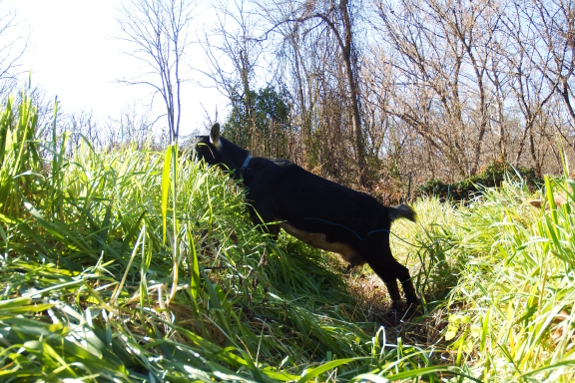
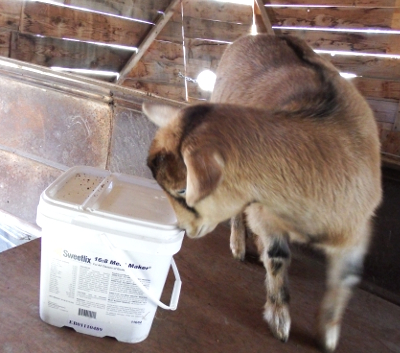 Oh the yelling and the
moaning! Taking
Artemesia away to be bred seemed to flick a switch in
our seven-month-old doeling. Previously quiet, little Aurora abruptly
found not only her voice but also her temper, head butting her mother
mercilessly when I took the two out to graze.
Oh the yelling and the
moaning! Taking
Artemesia away to be bred seemed to flick a switch in
our seven-month-old doeling. Previously quiet, little Aurora abruptly
found not only her voice but also her temper, head butting her mother
mercilessly when I took the two out to graze.
At first, I assumed the
change in behavior was due to the buck scent, which hung on Artemesia's
fur for several days after the event. But then, Saturday, I noticed
Mama Goat's udder looked very different. I'd thought she was easing Aurora off
the milk bar over the last couple of months, but her teats had remained
full and taut with liquid. Now, though, they're beginning to shrivel up
and one half of her udder is apparently quite dry.
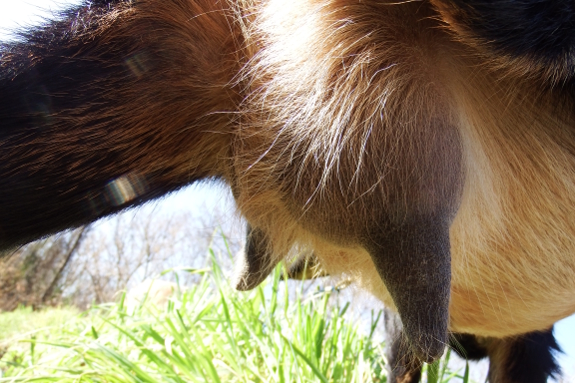
My new hypothesis is
both simpler and more complex. I suspect that being impregnated changed
Artemesia's hormone balance and she abruptly realized she needed to
stop feeding Aurora and save all of her energy for the new buns in her
oven. Cutting off the ever-flowing milk was a hard pill for little
Aurora to swallow, so she acted out like many of us do when we don't
get our way. With weaning nearly complete, though, our doeling's sunny
disposition is returning.
If I'm right, the other
half of Artemesia's udder should go dry in short order and we shouldn't
see any sign of heat during the first full week of December. Fingers
crossed the goat drama of the winter is behind us and I can now return
to my favorite part of caprine management --- spoiling our girls.
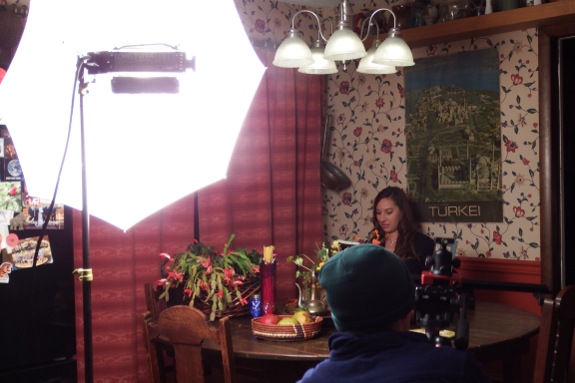
A behind the scenes look at one of our indoor scenes from Monday.
Want more in-depth information? Browse through our books.
Or explore more posts by date or by subject.
About us: Anna Hess and Mark Hamilton spent over a decade living self-sufficiently in the mountains of Virginia before moving north to start over from scratch in the foothills of Ohio. They've experimented with permaculture, no-till gardening, trailersteading, home-based microbusinesses and much more, writing about their adventures in both blogs and books.
